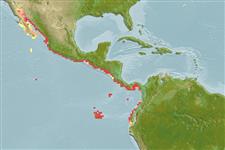Common names from other countries
Environment: milieu / climate zone / djupintervall / distribution range
Ekologi
marina pelagic-neritic; djupintervall 0 - 50 m (Ref. 188). Tropical; 33°N - 5°S, 116°W - 77°W (Ref. 188)
Eastern Pacific: Gulf of California to the Gulf of Guayaquil.
Size / Vikt / Age
Könsmognad: Lm ? range ? - ? cm
Max length : 15.9 cm TL hane/ej könsbestämd; (Ref. 124487); common length : 10.0 cm SL hane/ej könsbestämd; (Ref. 188); publicerad maxvikt: 34.85 g (Ref. 124487)
Short description
Bestämningsnycklar | Morfologi | Morfometri
Taggstrålar i ryggfenan (totalt) : 0; Mjukstrålar i ryggfenan (totalt) : 13 - 21; Taggstrålar i analfenan: 0; Mjukstrålar i analfenan: 12 - 23. Body moderately slender, quite strongly compressed, belly sharply keeled. The bright silver stripe along the flank distinguishes it from all similar clupeids in the area. Hind border of gill opening evenly rounded (with two fleshy outgrowths in Harengula and Opisthonema, the latter with a filamentous last dorsal fin ray).
Body shape (shape guide): fusiform / normal; Cross section: compressed.
A coastal-pelagic species that forms dense schools in beaches, lagoons and estuaries (Ref. 9291). Tolerates brackish and fresh waters (Ref. 9291). Feeds on plankton, especially on small crustaceans and fish larvae (Ref. 9291). Processed into oil and fishmeal (Ref. 37955).
Life cycle and mating behavior
Könsmognad | Reproduktion | Lek | Ägg | Fecundity | Larver
Whitehead, P.J.P., 1985. FAO Species Catalogue. Vol. 7. Clupeoid fishes of the world (suborder Clupeoidei). An annotated and illustrated catalogue of the herrings, sardines, pilchards, sprats, shads, anchovies and wolf-herrings. FAO Fish. Synop. 125(7/1):1-303. Rome: FAO. (Ref. 188)
IUCN Red List Status (Ref. 130435: Version 2025-1)
Threat to humans
Harmless
Human uses
Fiskeri: mindre kommeriell
Verktyg
Special reports
Download XML
Internet-källor
Estimates based on models
Preferred temperature (Ref.
123201): 20.6 - 28.5, mean 25.6 °C (based on 58 cells).
Phylogenetic diversity index (Ref.
82804): PD
50 = 0.5625 [Uniqueness, from 0.5 = low to 2.0 = high].
Bayesian length-weight: a=0.00871 (0.00561 - 0.01351), b=3.11 (2.98 - 3.24), in cm total length, based on LWR estimates for this species & (Sub)family-body (Ref.
93245).
Trofisk nivå (Ref.
69278): 3.5 ±0.43 se; based on food items.
Generation time: 0.8 ( na - na) years. Estimated as median ln(3)/K based on 1
growth studies.
Resiliens (Ref.
120179): Hög, lägsta populationsfördubblingstid mindre än 15 månader (K=1.36).
Fishing Vulnerability (Ref.
59153): Low vulnerability (10 of 100).
🛈
Nutrients (Ref.
124155): Calcium = 365 [180, 761] mg/100g; Iron = 2.75 [1.55, 4.72] mg/100g; Protein = 18.7 [17.6, 19.9] %; Omega3 = 0.44 [0.23, 0.82] g/100g; Selenium = 45 [21, 93] μg/100g; VitaminA = 31.1 [11.9, 83.4] μg/100g; Zinc = 1.77 [1.18, 2.68] mg/100g (wet weight);
